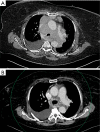Safety and feasibility of oesophageal ultrasound for the work-up of thoracic malignancy in patients with respiratory impairment
- PMID: 37559642
- PMCID: PMC10407489
- DOI: 10.21037/jtd-22-1705
Safety and feasibility of oesophageal ultrasound for the work-up of thoracic malignancy in patients with respiratory impairment
Abstract
Biopsying lung tumours with endobronchial access in patients with respiratory impairment is challenging. However, fine needle aspiration with the endobronchial ultrasound-endoscope via the oesophagus (EUS-B-FNA) makes it possible to obtain tissue samples without entering the airways. Safety of EUS-B-FNA in these patients has not earlier been investigated prospectively. Therefore, this study aimed at assessing feasibility and safety of EUS-B-FNA from centrally located tumours suspected of thoracic malignancy in patients with respiratory insufficiency. The study is a prospective observational study. Patients with indication of EUS-B-FNA of centrally located tumours and respiratory impairment defined as modified Medical Research Council (mMRC) dyspnoea scale score of ≥3, saturation ≤90% or need of continuous oxygen supply were included prospectively in three centres. Any adverse events (AEs) were recorded during procedure and 1-hour recovery. AEs were defined as hypoxemia (saturation <90% or need for increased oxygen supply) or any kind of events needing intervention. Late procedure-related events were recorded during 30-day follow-up. Between April 1, 2020 and January 30, 2021, 16 patients were included. No severe AEs (SAEs) occurred, but AEs were seen in 50% (n=8) and 13% (n=2) of the patients during procedure and recovery respectively. AEs included hypoxemia corrected with increased oxygen supply and in two cases reversal of sedation. Late procedure-related events were seen in 13% (n=2) and included prolonged need of oxygen and one infection treated with oral antibiotics. In this cohort, EUS-B-FNA of centrally located tumours was safe and feasible in patients with respiratory impairment, when examined in the bronchoscopy suite. A variety of mostly mild and manageable complications may occur, a few even up to 30 days post-procedure.
Keywords: Endobronchial ultrasound (EBUS); interventional pulmonology; lung cancer; respiratory insufficiency.
2023 Journal of Thoracic Disease. All rights reserved.
Conflict of interest statement
Conflicts of Interest: All authors have completed the ICMJE uniform disclosure form (available at https://jtd.amegroups.com/article/view/10.21037/jtd-22-1705/coif). ISC received unrestricted research grants from the following funds: the Danish Respiratory Society, Neye Fonden, Dagmar Marshalls Fond and Else og Mogens Wedell Wedellsborgs Fond. The other authors have no conflicts of interest to declare.
Figures

Similar articles
-
Combined endobronchial and esophageal endosonography for the diagnosis and staging of lung cancer: European Society of Gastrointestinal Endoscopy (ESGE) Guideline, in cooperation with the European Respiratory Society (ERS) and the European Society of Thoracic Surgeons (ESTS).Endoscopy. 2015 Jun;47(6):545-59. doi: 10.1055/s-0034-1392040. Epub 2015 Jun 1. Endoscopy. 2015. PMID: 26030890
-
Endoscopic Ultrasound with Bronchoscope-Guided Fine Needle Aspiration for the Diagnosis of Paraesophageally Located Lung Lesions.Respiration. 2019;97(4):277-283. doi: 10.1159/000492578. Epub 2018 Sep 25. Respiration. 2019. PMID: 30253411 Free PMC article.
-
Pulmonologist-performed transoesophageal sampling for lung cancer staging using an endobronchial ultrasound video-bronchoscope: an Australian experience.Intern Med J. 2017 Feb;47(2):205-210. doi: 10.1111/imj.13330. Intern Med J. 2017. PMID: 27860078
-
Utility and Safety of Endoscopic Ultrasound With Bronchoscope-Guided Fine-Needle Aspiration in Mediastinal Lymph Node Sampling: Systematic Review and Meta-Analysis.Respir Care. 2015 Jul;60(7):1040-50. doi: 10.4187/respcare.03779. Epub 2015 Mar 10. Respir Care. 2015. PMID: 25759463 Review.
-
The complete ''medical'' mediastinoscopy (EUS-FNA + EBUS-TBNA).Minerva Med. 2007 Aug;98(4):331-8. Minerva Med. 2007. PMID: 17921946 Review.
Cited by
-
A 47-Year-old Asian female with tracheobronchial space-occupying lesions caused by chronic lymphocytic leukemia.BMC Pulm Med. 2024 Oct 14;24(1):514. doi: 10.1186/s12890-024-03330-0. BMC Pulm Med. 2024. PMID: 39402476 Free PMC article.
-
Added value of EUS-B-FNA to bronchoscopy and EBUS-TBNA in diagnosing and staging of lung cancer.Eur Clin Respir J. 2024 Jun 9;11(1):2362995. doi: 10.1080/20018525.2024.2362995. eCollection 2024. Eur Clin Respir J. 2024. PMID: 38859948 Free PMC article. Review.
References
-
- Vilmann P, Clementsen PF, Colella S, et al. Combined endobronchial and oesophageal endosonography for the diagnosis and staging of lung cancer. European Society of Gastrointestinal Endoscopy (ESGE) Guideline, in cooperation with the European Respiratory Society (ERS) and the European Society of Thoracic Surgeons (ESTS). Eur Respir J 2015;46:40-60. 10.1183/09031936.00064515 - DOI - PubMed
LinkOut - more resources
Full Text Sources
Miscellaneous
